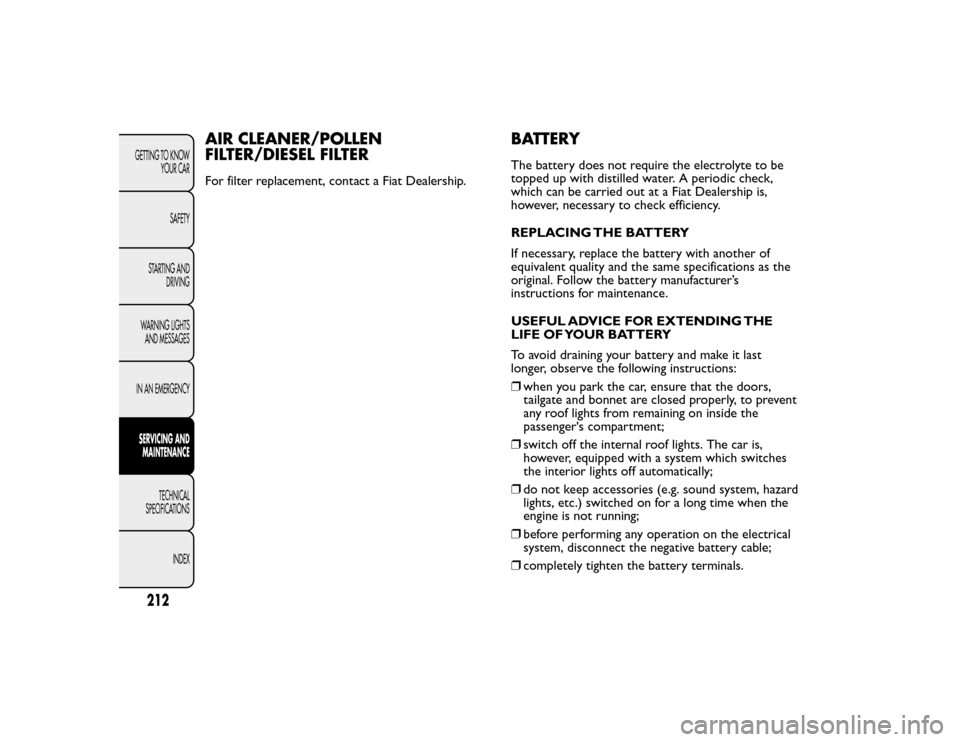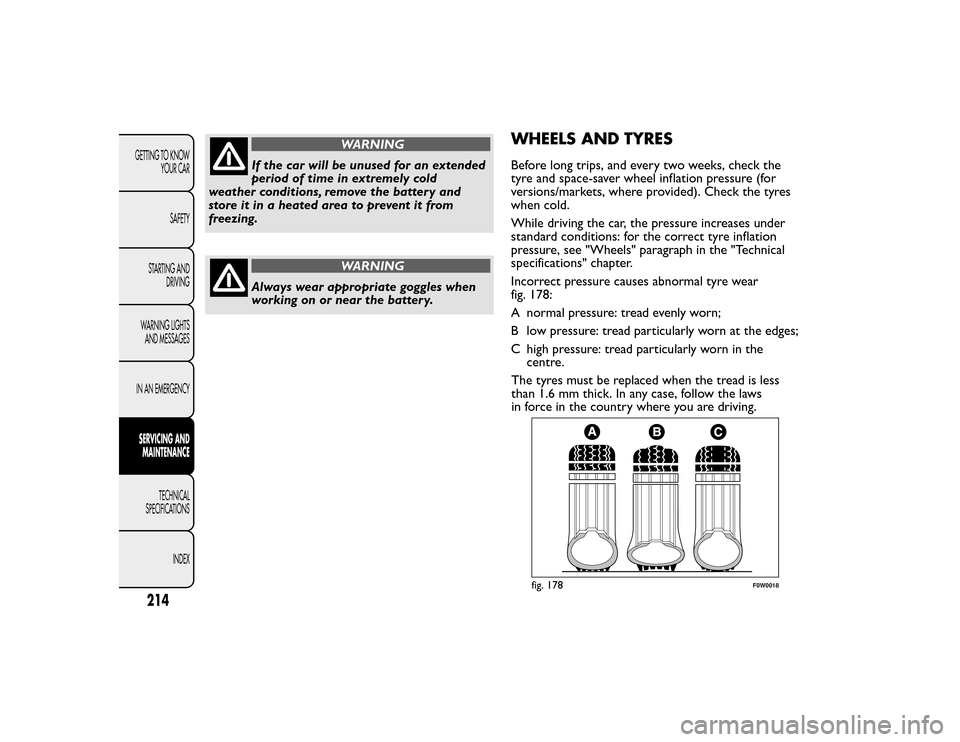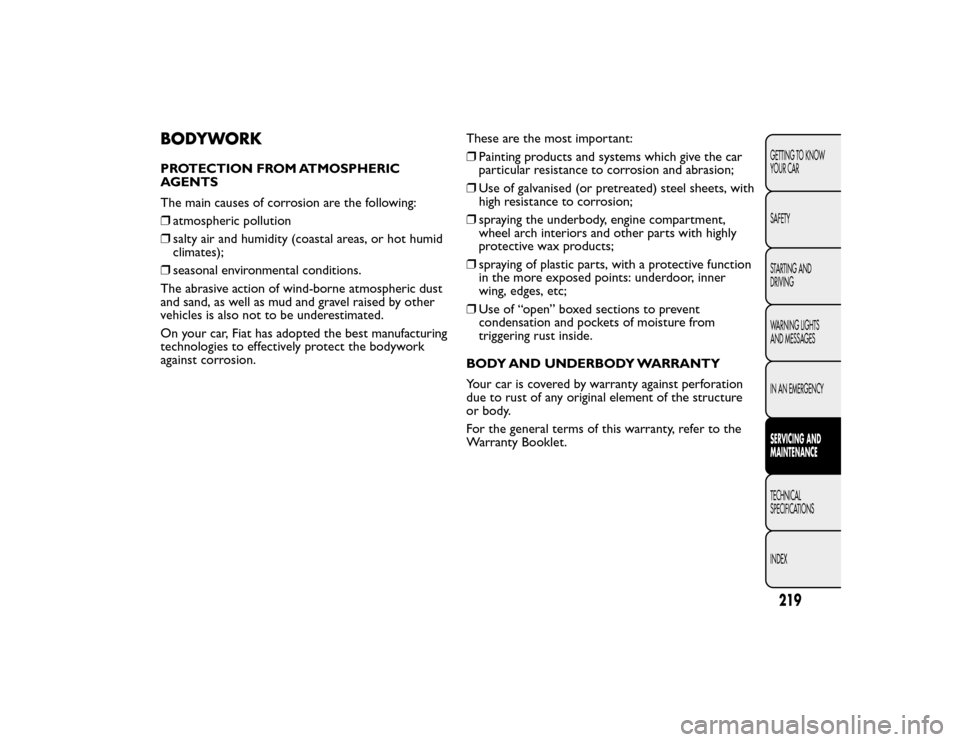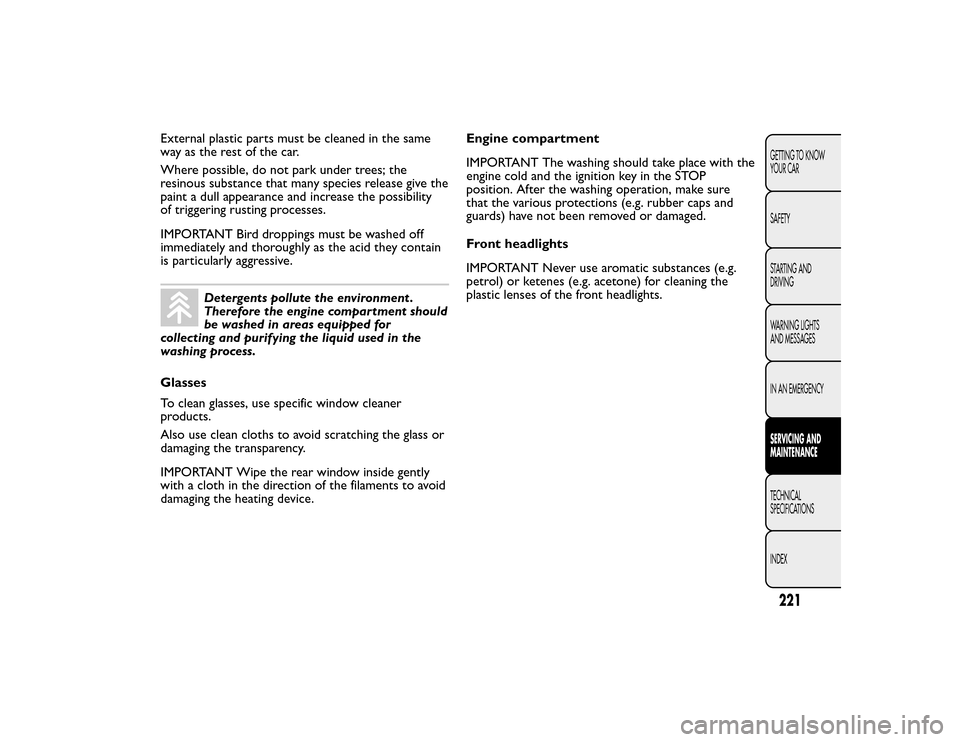technical specifications FIAT BRAVO 2015 2.G Owners Manual
[x] Cancel search | Manufacturer: FIAT, Model Year: 2015, Model line: BRAVO, Model: FIAT BRAVO 2015 2.GPages: 275, PDF Size: 7.55 MB
Page 216 of 275

AIR CLEANER/POLLEN
FILTER/DIESEL FILTERFor filter replacement, contact a Fiat Dealership.
BATTERYThe battery does not require the electrolyte to be
topped up with distilled water. A periodic check,
which can be carried out at a Fiat Dealership is,
however, necessary to check efficiency.
REPLACING THE BATTERY
If necessary, replace the battery with another of
equivalent quality and the same specifications as the
original. Follow the battery manufacturer’s
instructions for maintenance.
USEFUL ADVICE FOR EXTENDING THE
LIFE OF YOUR BATTERY
To avoid draining your battery and make it last
longer, observe the following instructions:
❒when you park the car, ensure that the doors,
tailgate and bonnet are closed properly, to prevent
any roof lights from remaining on inside the
passenger's compartment;
❒ switch off the internal roof lights. The car is,
however, equipped with a system which switches
the interior lights off automatically;
❒ do not keep accessories (e.g. sound system, hazard
lights, etc.) switched on for a long time when the
engine is not running;
❒ before performing any operation on the electrical
system, disconnect the negative battery cable;
❒ completely tighten the battery terminals.
212GETTING TO KNOW
YOUR CAR
SAFETY
STARTING AND DRIVING
WARNING LIGHTS AND MESSAGES
IN AN EMERGENCY SERVICING AND MAINTENANCE
TECHNICAL
SPECIFICATIONS
INDEX
Page 217 of 275

IMPORTANT If the charge level remains under 50%
for a long time, the battery is damaged by sulphation,
reducing its capacity and efficiency at start-up.
The battery will also be more at risk of freezing (this
can happen as early as -10°C). Refer to the paragraph
"Car inactivity" in "Starting and driving" if the car is
left parked for a long time.
If, after buying the car, you wish to install electrical
accessories which require permanent electrical
supply (alarm, etc.) or accessories which influence
the electrical supply requirements, contact a Fiat
Dealership, whose qualified staff will evaluate the
overall electrical consumption.
WARNING
Battery fluid is poisonous and corrosive.
Avoid contact with the skin and eyes.
Keep open flames away from the battery and
do not use objects that might create sparks: risk
of explosion and fire.
WARNING
Using the battery with insufficient fluid
irreparably damages the battery and
may cause an explosion.
Incorrect installation of electrical and
electronic devices may cause severe
damage to your car. After purchasing your
car, if you wish to install any accessories
(anti-theft , car phone, etc .), contact a Fiat
Dealership, which will suggest the most
appropriate devices for your vehicle, and will,
most importantly, advise you if a higher capacity
battery needs to be installed.Batteries contain substances which are
very dangerous for the environment . For
battery replacement , contact a Fiat
Dealership.
213GETTING TO KNOW
YOUR CAR
SAFETY
STARTING AND
DRIVING
WARNING LIGHTS
AND MESSAGES
IN AN EMERGENCY
SERVICING AND
MAINTENANCE
TECHNICAL
SPECIFICATIONS
INDEX
Page 218 of 275

WARNING
If the car will be unused for an extended period of time in extremely cold
weather conditions, remove the battery andstore it in a heated area to prevent it fromfreezing.
WARNING
Always wear appropriate goggles whenworking on or near the battery.
WHEELS AND TYRESBefore long trips, and every two weeks, check thetyre and space-saver wheel inflation pressure (forversions/markets, where provided). Check the tyreswhen cold. While driving the car, the pressure increases under standard conditions: for the correct tyre inflationpressure, see "Wheels" paragraph in the "Technicalspecifications" chapter. Incorrect pressure causes abnormal tyre wear fig. 178: A normal pressure: tread evenly worn;B low pressure: tread particularly worn at the edges;C high pressure: tread particularly worn in the
centre.fig. 178
F0W0018
214GETTING TO KNOW
YOUR CARSAFETY
STARTING AND
DRIVING
WARNING LIGHTSAND MESSAGESIN AN EMERGENCYSERVICING ANDMAINTENANCE
TECHNICAL
SPECIFICATIONS
INDEX
The tyres must be replaced when the tread is less than 1.6 mm thick. In any case, follow the lawsin force in the country where you are driving.
Page 219 of 275

IMPORTANT Take the following precautions to prevent damage to the tyres: ❒
avoid braking suddenly, racing starts and violent impact against the curb, potholes or otherobstacles and driving for extended periods onuneven road surfaces;
❒
periodically check that the tyres have no cuts inthe side wall, abnormal swelling or irregular tyrewear;
❒
avoid travelling with the car overloaded. If youhave a puncture, stop immediately and change thetyre;
❒
tyres age even if they are not used much. Cracks inthe tread rubber and at the sides are a sign ofageing. In any case, if the tyres have been on thecar for over 6 years, they should be checkedby specialised personnel. Also remember to checkthe space-saver wheel very carefully (forversions/markets, where provided);
❒
change the position of the tyres every 10-15thousand kilometres, keeping them on the sameside of the car to avoid inverting the rotationdirection;
❒
In the case of replacement, always fit new tyres,avoiding those of dubious origin;
❒
if a tyre is changed, also change the inflation valve.
WARNING
The road holding qualities of the caralso depend on the correct inflation
pressure of the tyres.
WARNING
If the pressure is too low the tyreoverheats and can be seriously
damaged.
215GETTING TO KNOWYOUR CAR SAFETYSTARTING AND DRIVING WARNING LIGHTS AND MESSAGES IN AN EMERGENCYSERVICING AND MAINTENANCE TECHNICAL SPECIFICATIONS INDEX
Page 220 of 275

WARNING
Do not cross switch the tyres, moving
them from the right of the car to the
left and vice versa.WARNING
Never submit alloy rims to repainting
treatments requiring the use of
temperatures exceeding 150°C.The mechanical
properties of the wheels could be impaired.
WINDSCREEN/REAR WINDOW
WIPERBLADES
Periodically clean the rubber part using special
products; TUTELA PROFESSIONAL SC 35 is
recommended.
Replace the blades if the rubber edge is deformed or
worn. In any case, it is advisable to replace them
approximately once a year. A few simple precautions
can reduce the possibility of damage to the blades:
❒ if the temperature falls below zero, make sure that
ice has not frozen the rubber against the glass. Use
an antifreeze product to release it if required;
❒ remove any snow from the glass: in addition to
protecting the blades, this prevents effort on
the motor and overheating;
❒ do not operate the windscreen/rear window
wipers on dry glass.
WARNING
Driving with worn windscreen/rear
window wiper blades is a serious hazard,
because visibility is reduced in bad weather.
216GETTING TO KNOW YOUR CAR
SAFETY
STARTING AND DRIVING
WARNING LIGHTS AND MESSAGES
IN AN EMERGENCY SERVICING AND MAINTENANCE
TECHNICAL
SPECIFICATIONS
INDEX
Page 221 of 275

Replacing the wiper blades
Proceed as follows:
❒lift up the windscreen wiper arm and position the
blade so that it forms a 90° angle with the arm;
❒ press tab A fig. 179 of the coupling spring and
remove the blade to be replaced from the arm;
❒ fit the new blade by inserting the tab into the
special slot in the arm. Make sure that the new
blade is secured in position. Replacing the rear window wiper blade
Proceed as follows:
❒
raise cover A fig. 180 and remove the arm from
the car undoing the nut B that fastens it to the
pivot pin;
❒ correctly position the new arm and tighten the nut
fully;
❒ lower the cover.
fig. 179
F0Q0662
fig. 180
F0Q0663
217GETTING TO KNOW
YOUR CAR
SAFETY
STARTING AND
DRIVING
WARNING LIGHTS
AND MESSAGES
IN AN EMERGENCY
SERVICING AND
MAINTENANCE
TECHNICAL
SPECIFICATIONS
INDEX
Page 222 of 275

NOZZLES
Windscreen (washer)
If the jet is not coming out, firstly check that there is
fluid in the reservoir (see “Checking levels” in this
chapter). Then check that the nozzle holes, marked
by arrows in Fig. fig. 181, are not clogged; if
necessary use a needle. The window washer nozzles
are fixed.Rear window (washer)
The rear window washer nozzles are fixed.
The nozzle holder is on the rear window fig. 182.
fig. 181
F0Q0661
fig. 182
F0Q0660
218GETTING TO KNOW
YOUR CAR
SAFETY
STARTING AND DRIVING
WARNING LIGHTS AND MESSAGES
IN AN EMERGENCY SERVICING AND MAINTENANCE
TECHNICAL
SPECIFICATIONS
INDEX
Page 223 of 275

BODYWORKPROTECTION FROM ATMOSPHERIC
AGENTS
The main causes of corrosion are the following:
❒atmospheric pollution
❒ salty air and humidity (coastal areas, or hot humid
climates);
❒ seasonal environmental conditions.
The abrasive action of wind-borne atmospheric dust
and sand, as well as mud and gravel raised by other
vehicles is also not to be underestimated.
On your car, Fiat has adopted the best manufacturing
technologies to effectively protect the bodywork
against corrosion. These are the most important:
❒
Painting products and systems which give the car
particular resistance to corrosion and abrasion;
❒ Use of galvanised (or pretreated) steel sheets, with
high resistance to corrosion;
❒ spraying the underbody, engine compartment,
wheel arch interiors and other parts with highly
protective wax products;
❒ spraying of plastic parts, with a protective function
in the more exposed points: underdoor, inner
wing, edges, etc;
❒ Use of “open” boxed sections to prevent
condensation and pockets of moisture from
triggering rust inside.
BODY AND UNDERBODY WARRANTY
Your car is covered by warranty against perforation
due to rust of any original element of the structure
or body.
For the general terms of this warranty, refer to the
Warranty Booklet.
219GETTING TO KNOW
YOUR CAR
SAFETY
STARTING AND
DRIVING
WARNING LIGHTS
AND MESSAGES
IN AN EMERGENCY
SERVICING AND
MAINTENANCE
TECHNICAL
SPECIFICATIONS
INDEX
Page 224 of 275

ADVICE FOR PRESERVING THE
BODYWORK
Paint
Paintwork does not only serve an aesthetic purpose,
but also protects the underlying sheet metal.
Touch up abrasions and scratches immediately to
prevent rust formation. Use only original paint
products for touch-ups (see “Bodywork paint
identification plate” in the “Technical specifications”
section).
Normal maintenance of paintwork consists in
washing the car: the frequency depends on the
conditions and environment where the car is used.
For example, in highly polluted areas, or if the roads
are spread with salt, it is advisable to wash the car
more frequently.To correctly wash the vehicle, proceed as follows:
❒
remove the aerial from the roof to prevent damage
to it if the car is washed in an automatic system;
❒ if high pressure jets or cleaners are used to wash
the vehicle, keep a distance of at least 40 cm
from the bodywork to avoid damage or alteration.
It should be remembered that the build up of
water can damage the car over a period of time;
❒ wash the body using a low pressure jet of water;
❒ wipe a sponge with a slightly soapy solution over
the bodywork, frequently rinsing with the sponge;
❒ rinse well with water and dry with a jet of air or a
chamois leather.
Dry the less visible parts particularly carefully, such
as the door frames, bonnet and the headlight frames,
where water may stagnate more easily. The car
should not be taken to a closed area immediately,
but left outside so that residual water can evaporate.
Do not wash the car after it has been left in the
sun or with the bonnet hot: this may alter the shine
of the paintwork.
220GETTING TO KNOW YOUR CAR
SAFETY
STARTING AND DRIVING
WARNING LIGHTS AND MESSAGES
IN AN EMERGENCY SERVICING AND MAINTENANCE
TECHNICAL
SPECIFICATIONS
INDEX
Page 225 of 275

External plastic parts must be cleaned in the same
way as the rest of the car.
Where possible, do not park under trees; the
resinous substance that many species release give the
paint a dull appearance and increase the possibility
of triggering rusting processes.
IMPORTANT Bird droppings must be washed off
immediately and thoroughly as the acid they contain
is particularly aggressive.
Detergents pollute the environment .
Therefore the engine compartment should
be washed in areas equipped for
collecting and purifying the liquid used in the
washing process.
Glasses
To clean glasses, use specific window cleaner
products.
Also use clean cloths to avoid scratching the glass or
damaging the transparency.
IMPORTANT Wipe the rear window inside gently
with a cloth in the direction of the filaments to avoid
damaging the heating device. Engine compartment
IMPORTANT The washing should take place with the
engine cold and the ignition key in the STOP
position. After the washing operation, make sure
that the various protections (e.g. rubber caps and
guards) have not been removed or damaged.
Front headlights
IMPORTANT Never use aromatic substances (e.g.
petrol) or ketenes (e.g. acetone) for cleaning the
plastic lenses of the front headlights.
221GETTING TO KNOW
YOUR CAR
SAFETY
STARTING AND
DRIVING
WARNING LIGHTS
AND MESSAGES
IN AN EMERGENCY
SERVICING AND
MAINTENANCE
TECHNICAL
SPECIFICATIONS
INDEX